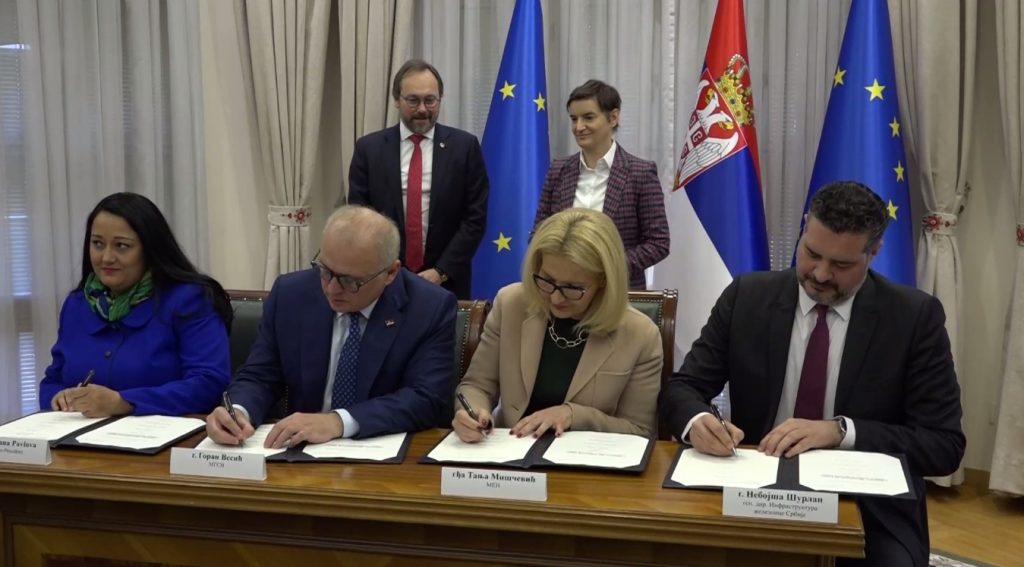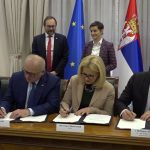 The Government of Serbia and the European Investment Bank (EIB) have signed a second EUR 174.5 million grant for the modernisation of Paraćin – Međurovo rail section via Trupale part of the Belgrade – Niš railway on Corridor X.
The Government of Serbia and the European Investment Bank (EIB) have signed a second EUR 174.5 million grant for the modernisation of Paraćin – Međurovo rail section via Trupale part of the Belgrade – Niš railway on Corridor X.
The agreement was signed by Vice President of the European Investment Bank Lilyana Pavlova, the Minister of Construction, Transport and Infrastructure Goran Vesicj, the Minister of European Integration Tanja Miščević and the Director General of the Railway Infrastructure of Serbia, Nebojša Šurlan. The contract was signed in the presence of the Prime Minister Ana Brnabić, the EU Ambassador to Serbia Emanuele Giaufret and representatives of Serbian Railways.
“The Belgrade – Niš railway section is just such a project, as is the Paraćin – Međurovo rail section for which the investment grant was signed now. Its construction will facilitate travel for people in Serbia and better connection with the region,” Prime Minister of the Republic of Serbia Ana Brnabić said.
The project for the 48.3 km Paraćin – Trupale – Međurovo subsection covers upgrade works and double-track works including electrification and the installation of signalling and telecommunication systems.
According to the WBIF, EUR 475.6 million is the total financing to modernise this section, EUR 174.6 million being covered by a WBIF grant and EUR 265.2 million by loans provided by the EIB (EUR 188.28 million) and EBRD (EUR 76.9 million). EUR 29.5 million is the state funding while EUR 6.3 million is an external grant from EU IPA.
The latest grant was signed on March 30, 2023, and is part of a EU financial package of EUR 2.2 billion to support the modernisation and upgrade of Belgrade – Niš railway. The package comprises up to EUR 600 million in EU grants and also includes a EUR 1.1 billion loan from the EIB and a EUR 550 million loan from the European Bank for Reconstruction and Development (EBRD) for which the agreement has been signed in February, when a EUR 82.3 million grant under the Western Balkans Investment Framework was signed.
The President of Serbia Aleksandar Vučić and the EU Commissioner for Neighbourhood and Enlargement, Olivér Várhelyi, met in Belgrade in February when announced the provision of the EUR 600 million grant for Belgrade – Niš line. The grant will also support the modernisation and double track construction of the 18 km Stalac – Djunis section, which part of the third stage of the mainline.
“We have already signed two grants for this important project within a single month. This proves the commitment of the European Union and its institutions to delivering new, upgraded railways between two pivotal cities in Serbia, linking the country to the region — and further to the European Union, as this route is part of the pan-European Railway Corridor X,” Lilyana Pavlova said.
The funds will enable the upgrade and modernisation of 230 km of Belgrade – Niš railway. This will enable travel speeds of up to 200 km/h between the two important Serbian cities, increasing trade flows and stimulating economic growth along the route. Thanks to the implementation of the project, the travel time will be reduced by alsmot four hours, from currently six hours to only 100 minutes.
“Due to all of that, travelling and transporting goods by train will be more attractive to citizens and the economy. And in this way, our country, in partnership with the European Union and with its support, is achiving its goal of becoming infrastructurally connected with neighboring countries and Europe as a whole, which in turn contributes to the overall development of Serbia,” Minister Miščević stressed.
“After the launch of the fast railway to Novi Sad [to Belgrade] a similar railway to Subotica is being built, and the construction of a 228-km high-speed railway to Niš is now starting. We are also expecting that the high-speed connection to Preševo will be built in the future,” the Minister of Transport said.
To increase cross-border connectivity, the ministries of transport from Serbia and Hungary launched an initiative to create fast rail connections with Bulgaria, Greece, Turkey, Albania and North Macedonia. Serbia and Hungary will sent their initiative to these countries and plan to establish several meetings to implement the ambitious programme.
The railway projects “make sense if they stretch along the entire European continent,” the minister said, adding that he expects the initiative to be endorsed by the “European partners, financial institutions and potential creditors. We plan to develop five projects in the region which will bring benefits to the entire Europe.”
Share on:








